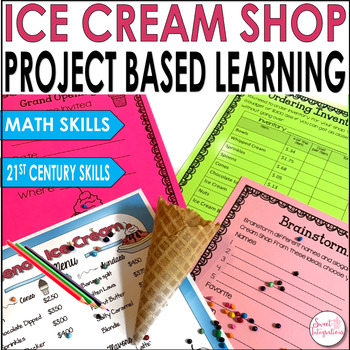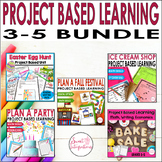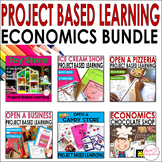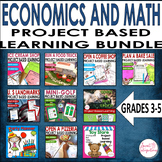Project Based Learning Math - Open and Run an Ice Cream Shop - With Digital
- Zip
What educators are saying
Also included in
- With this project based learning bundle, students learn about entrepreneurship, budgeting, and economics. These student-centered PBL units incorporate collaboration and differentiation by providing student choice. The real-world challenges require students to use inquiry, critical thinking, and theiPrice $12.50Original Price $23.15Save $10.65
- PROJECT BASED LEARNING (PBL): ECONOMICS BUNDLE : With this pbl ideas bundle, students learn about entrepreneurship, and economics. These student-centered PBL units incorporate collaboration and differentiation by providing student choice. The real-world challenges require students to use inquiry, crPrice $26.25Original Price $37.50Save $11.25
- This Project Based Learning bundle includes 10 different math and economics units to use throughout the whole year. These PBL units incorporate 21st Century skills with challenging, engaging, and creative activities. There are lots of opportunities for differentiation and technology integration.IN EPrice $30.00Original Price $54.80Save $24.80
- Inspire budding entrepreneurs with this Economics Project Based Learning Bundle! In these PBL units, students will go through all the steps of opening their own restaurants. Your students will love the variety in this bundle!WHY SHOULD YOU GRAB THIS PBL UNIT?Your students will love sharing their crePrice $35.21Original Price $50.30Save $15.09
Description
Everyone loves ice cream! This student-centered (real-world) project based learning math unit incorporates collaboration and differentiation by providing student choice. As your students open and run their own ice cream shop, they also learn about the history of ice cream, entrepreneurship, and economics.
This OPEN AN ICE CREAM SHOP real-world math challenge requires students to use inquiry, critical thinking, and their creative minds during the high-interest cross-curricular activities [math, social studies, ELA]. Students integrate digital learning into the project based learning math unit as they investigate and complete their final product. (Updated to include digital learning)
Students have an opportunity to create their own menu, make their favorite flavor of ice cream, and more. This Project Based Learning Math unit can be done collaboratively as a group or as an independent study. It's a perfect differentiation unit for your high achievers and earlier finishers. Students integrate digital learning into the Ice Cream Shop project as they investigate, learn about running a business, and complete their final product.
WHY TEACHERS LOVE PBL...
- This PBL unit incorporates 21st Century skills with challenging, engaging, and creative activities.
- There are lots of opportunities for differentiation, cooperative learning, and technology integration.
- This real-world challenge requires students to use inquiry, critical thinking, and creative minds during high-interest cross-curricular activities [math, STEM, social studies, ELA].
- Easily adapted for enrichment for early finishers or gifted students in other grade levels.
- This student-centered PBL unit incorporates collaboration and differentiation by providing student choice.
IN THIS UNIT...
- Learn about the history of ice cream, different shops, and creameries. (websites and apps)
- Photos of the visit to Amy’s Ice Cream
- Take a survey to learn about favorite ice cream flavors. Graph results
- Create questions for the business survey. Record results
- Questions about starting an ice cream shop
- Choose a name, logo, and slogan for your Ice Cream Shop.
- Design a storefront (use my template or design your own)
- Create your own business plan (company overview)
- Interview an owner or manager of an ice cream shop.
- Create a new flavor of ice cream and describe it.
- Create a new ice cream sundae.
- Design a flyer to advertise your shop. (This can be done on the computer or on a blank sheet of paper.) Make sure to include important info about your shop.
- Design business cards
- Create coupons for your ice cream shop.
- Plan a menu for your ice cream shop. – Students can even create their own design after using this template as a rough draft.
- Inventory (choice of using a spreadsheet)
- Plan social media for your ice cream shop
- Ice Cream recipes
- Use a spreadsheet to take orders.
- Additional ideas
- Build a Sundae Game
**Note: Activities can easily be adapted for enrichment or gifted students in other grade levels.
TEACHERS LIKE YOU SAID ABOUT MY RESOURCES...
⭐️⭐️⭐️⭐️⭐️ "This has been my favorite purchase year-to-date. I had to stay behind with students who couldn't go on a field trip, and they didn't feel left out at all. I used it to reinforce close reading skills, context clues, decimal work and research skills. On the last day, we held an ice cream social and presented our projects."
⭐️⭐️⭐️⭐️⭐️ "I utilized this resource for my students when we were participating in distance learning. They loved it! I plan to make this a yearly activity with my students as it will work well in person as well. "
⭐️⭐️⭐️⭐️⭐️ "This is highly engaging! Thank you for your attention to detail and easy step-by-step instructions for both kids and me. What a fun way to reinforce our ATL skills. We had some fun end products with the ice cream vans. Will definitely use this again."
*******************************************************************
YOU MAY ALSO LIKE OTHER PROJECT BASED LEARNING MATH UNITS…
→ Project Based Learning Units
*******************************************************************
Copyright © Sweet Integrations. All rights reserved by the author.
Permission to copy for one classroom only. You can purchase additional licenses if more than one classroom uses the product.
© 2015 Google and the Google Apps are registered trademarks of Google Inc.
*******************************************************************
Follow Me for sales, product launches, and FREE resources.
*******************************************************************
Drop by my blog, Sweet Integrations for more ideas for your classroom!









